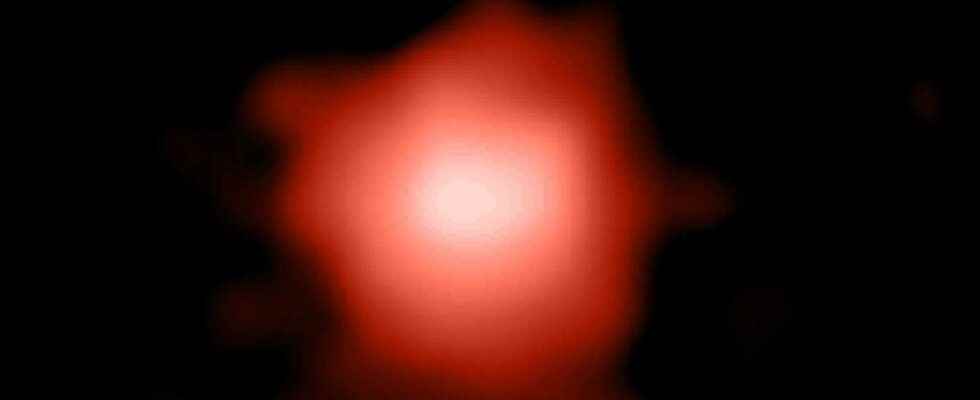We know that the James Webb Space Telescope has a mirror larger than that of Hubble which allows him to see further and better than Hubble in L’infrared. But to have access to strata of light the oldest in cosmos observable, both instruments must use strong gravitational lenses.
As part of the Glass observation campaign (Grism Lens-Amplified Survey from Space)them astrophysicists had already used the galaxy cluster Abell 2744 to see far, taking advantage of its field of gravitation which deviates the light rays from stars in the background, like the lens of a magnifying glass.
As this video shows, Hubble was already making gravitational lensing observations for the galaxy cluster Abell 2744. © Nasa, ESA, and J. Lotz, M. Mountain, A. Koekemoer, and the HFF Team ( STScI)
Quite naturally, the members of Glass put their experience with Hubble at the service of the scientific community using the James-Webb and they therefore provided images that could be used by their colleagues.
These have just deposited an article on arXiv in which they announce that they have discovered in these images two distant and already massive galaxies less than a billion years after the big Bang. One of them, called Glass-z13, would even be the oldest known to members of the noosphere who would observe it today only between 300 and 400 million years after the Big Bang, which would break a record. previously owned by Hubble.
Large galaxies with already billions of stars
Among the members of the team that made the discovery of Glass-z13 is theastronomer Pieter van Dokkum, well known for his work on the enigma of ultra-diffuse galaxies. Recall that cosmologists are used to expressing a distance for galaxies using Milky Way by means of a parameter denoted “z” and which is a measure of their spectral redshift, the higher z, the greater the galaxy is distant.
Pieter van Dokkum explains on his account Twitter : “ Here are the first results on the first luminous galaxies in the cosmos delivered by the JWST! Rohan Naidu and Pascal Oesch discovered two relatively bright galaxies in the first data broadcast at z=11-13, while theUniverse was only 2.5% of his current age. The tentative conclusion, supported by work prior to a red shift slightly lower, is that massive galaxy formation started early – which is good news for the prospects of finding things at even earlier times with the JWST! The data is of such quality that it is even possible to measure the morphology of these extremely distant galaxies. The larger of the two is clearly resolved; it has an exponential profile with a radius of 0.7 kpc “.
First results on luminous early galaxies from JWST! @Rohan_Naidu and Pascal Oesch find two relatively bright galaxies in early release data at z=11-12, when the universe was only 2.5% of its present age: https://t.co/zmEcZIZCrr
— Pieter van Dokkum (@DokkumPieter) July 20, 2022
The researchers’ paper states that the two galaxies already appear to contain about 109 masses solar in the form ofstars. Remember that one kpc (kiloparsec) roughly corresponds to 3,260 light-years. Remarkably, Stacy McGaugh, the astrophysicist and cosmologist well known for her work on WORLD and who studies galaxies, dark matter and modified gravity theories, had let it be known at the beginning of the year 2022 that according to him, the JWST would show us many large galaxies formed already early in the history of the observable cosmos and that this could probably rather support the MOND theory than the existence of matter black.
For those watching the astro community freak out about bright, high redshift galaxies being detected by JWST, some historical context in an amusing anecdote…
—Stacy (@DudeDarkmatter) July 20, 2022
We can also consult, although it is more technical, the explanations of Rohan Naidu on Twitter.
Paper day! “Two Remarkably Luminous Galaxy Candidates at z~11-13 Revealed by the Just Wonderful Space Telescope”. These galaxies potentially push our cosmic frontier to only ~300 million years after the Big Bang!!! https://t.co/4aAP0nKhpz ????and behind the scenes notes pic.twitter.com/eS79MXcGNq
—Rohan Naidu (@Rohan_Naidu) July 21, 2022
A desire to escape for the summer?
To celebrate the holidays as it should be, discover the Mag Futura at the preferential price of €15 instead of €19, i.e. a reduction of 20% !
On the program of this issue: a dive into the heart of 4 scientific themes that will mark 2022, from the Earth to the Moon:
- What mysteries does the Moon still hide from us?
- Will we soon be able to cure everything thanks to genes?
- How to feed the world without destroying it?
- Can artificial intelligence become truly intelligent?
What is Mag Futura?
- Our first paper journal of more than 200 pages to make science accessible to as many people as possible
- 4 major scientific questions for 2022, from the Earth to the Moon
- Home delivery*
*Delivery is made in France (excluding metropolitan France), Switzerland, Belgium.
Interested in what you just read?
